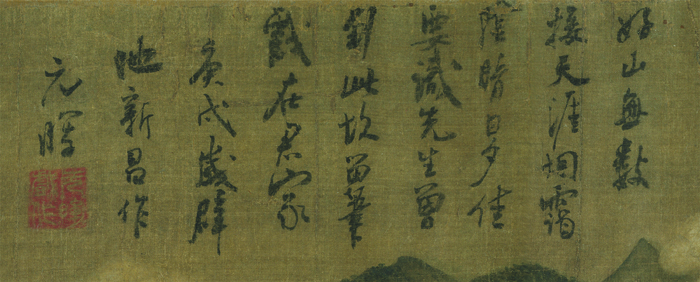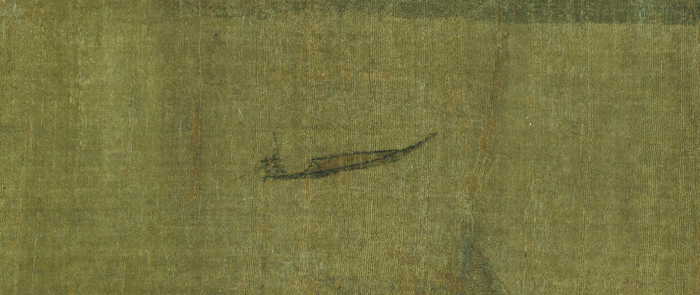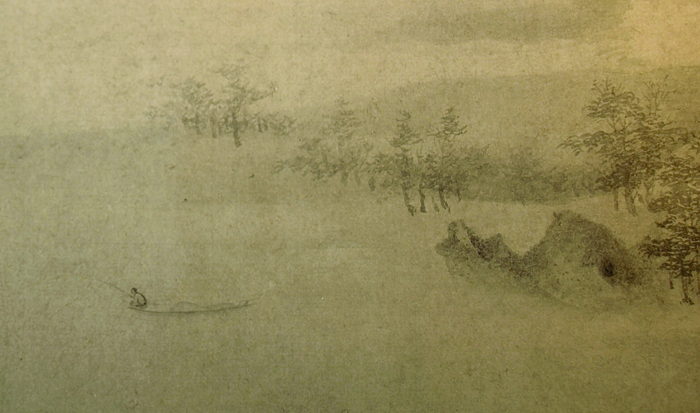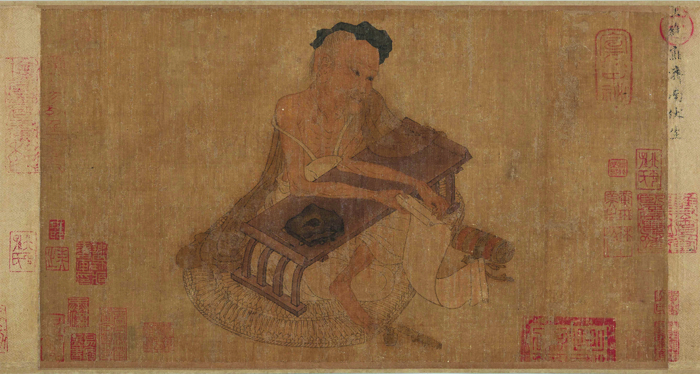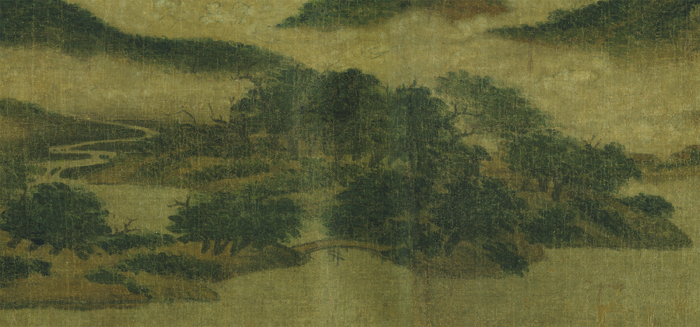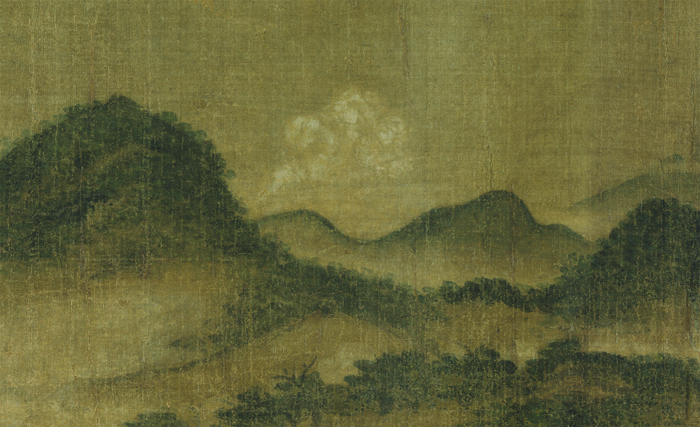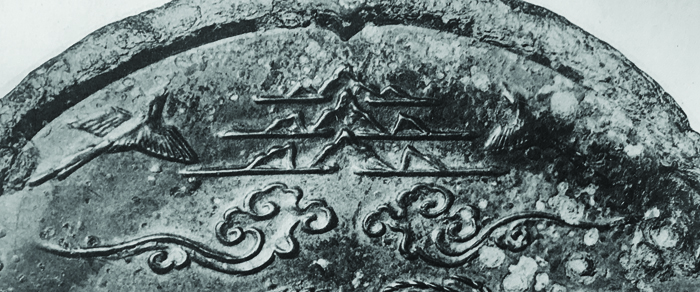Especially after the time of the art-theorist Dong Qichang 董其昌 (1555–1636), evoking the person and painting of Wang Wei 王維 (699–759) as inspiration became one of the more conventional practices in Chinese landscape painting. Established by Dong at the headwaters of his Southern School—the transhistorical lineage of preferred painters whose patrimony could be elicited with the simplest of formal means—it mattered little that this famed poet and sometimes painter of the Tang dynasty (618–907) remained among the most elusive of sources. Wang’s name alone was enough to establish linkage with the principles and expectations that represented orthodoxy in later imperial Chinese painting. In contrast, as Wen Fong and others have demonstrated, Dong’s own efforts to excavate Wang Wei’s image were remarkable—a creative act stemming from equal amounts knowledge, intuition, and imagination.1 For a creative and confident artist like Dong, Wang’s mythic status, combined with the material elusiveness of his paintings, offered a particularly potent stimulus. Concretizing Wang Wei with old paintings, regardless of how dubious those attributions may strike us today, was essential for both Dong’s painting practice and theoretical stance.
Dong Qichang’s engagement with the Wang Wei tradition is referenced here to provide perspective on what proves to be a phenomenon that has earlier precedents. In fact, the act of evoking Wang Wei has a remarkably long and persistent history. It is well known that Dong’s pursuit of the Tang painter echoed the much earlier use of Wang’s reputation as painter and poet by the polymath Su Shi 蘇軾 (1037–1101) to help define the painting of scholar-officials (shidaifu 士大夫) in the Northern Song (960–1127), and a rudimentary outline of how that reputation took shape leading to Su Shi’s time also is known from modern scholarship.2 Less studied is Wang Wei’s image after Su Shi. This article offers a brief glimpse at this act of evoking Wang in the generation that immediately followed Su at the very end of the Northern Song. This is not a comprehensive review, which would be a worthy project in its own right for understanding developments in painting during the reign of Song Huizong 宋徽宗 (r. 1100–1126), but rather a very limited look at one painter, Mi Youren 米友仁 (1074–1151), and for the most part one painting, his Cloudy Mountains (Yunshan tu 雲山圖) of 1130 in the Cleveland Museum of Art (fig. 1). Mi Youren’s painting and relevant inscriptions offer only a fragmentary glance at a moment in his life, but it was a particularly important moment that followed the near destruction of the dynasty. Under these difficult circumstances, we learn how the act of citation could be as much about personal loss as artistic gain. On the one hand, the goal here is to reveal, through a close examination of Mi’s painting, potential complexities in the Song artist’s use of citation. Beyond Mi’s personal circumstances, however, what can be gleaned of these materials also points to the broader narrative regarding the evolution of Wang Wei’s image in literati painting.
Cloudy Mountains
On a separate (and long lost) landscape painting precisely dated the seventh day of the eighth lunar month in the year 1130, Mi Youren added a lengthy inscription that suggests the anxiety of facing a world that, to all appearances, was coming apart at the seams:
Ziyun [Yang Xiong 揚雄; 53 BCE–18 CE] considered calligraphy to be pictures of the heart.3 If he were not one who thought deeply, he would never have reached this conclusion. To give a definition for painting, it, too, is pictures of the heart. In high antiquity, only the outstanding talents of an age would know this. How could a common artisan of the local market comprehend?
The landscape [paintings] from the beginning of time through the Han [206 BCE–220 CE] and the Six Dynasties period [220–589] are no longer seen in this world. Only the Right Executive Assistant Wang Mojie [Wang Wei] stepped alone from ancient times to modern. In the past, my secret collection of paintings was extensive, but as I awakened to the secrets of the “reds and blues,” looking at their brush-ideas I dismissed them with a laugh. All of the rare and wonderful Xiao-Xiang views between heaven and earth are like this.
Since antiquity there have never been scholars and men of talent who were not envied, ostracized, and slandered in their own time. This is nothing strange. It takes one hundred generations before an honest evaluation emerges. In 1129 I fled the fires of war to Jintan, continuing on to Xinchang and the home of the reclusive gentleman, Jiang Zhongyou. I have lived in this country dwelling now for seven months. This painting is not something a great nobleman can acquire; it is not something he can even seek out. And in fact, this is something the whole world knows. For this reason, I playfully inscribe the following poem on this painting:
Deep in labyrinthine mountains—here are mists and haze;
Rains dark, clear radiance: lovely both day and night.
To make known that the gentleman once reached this place,
I leave a play of my brush at the house of my host.
The seventh day of mid-autumn [the eighth lunar month], gengxu 庚戌 year of the Jianyan 建炎 reign [September 11, 1130]. [Signed] Yuanhui [Mi Youren].
子雲以字為心畫,非窮理者,其語不能至是。畵之為説,亦心畫也。從古莫非一世之英,乃悉為此,豈市井庸工所能曉。自開闢以來,漢與六朝作山水者不復見于世,惟右丞王摩詰古今獨步。僕舊祕蔵甚多,既自悟丹青妙處,觀其筆意但付一笑耳。霄壤間所有瀟湘竒觀葢如是也。自古文人才士無不為世所忌,擠毁下石,無足怪者,百世之下方自有公論。僕己酉嵗避兵火於金壇,繼至新昌隠君子蔣仲友舘。僕於村舍者七閱月。此畵非大貴人可得,亦非大富者可求,實一世之所共知,因戱作小詩於畵云:亂山深處是烟霞,雨暗晴暉日夕佳,要識先生曾到此,故留戱筆在君家。庚戌仲秋建炎紀嵗初七日,元暉。4
Before examining the multiple dimensions to Mi Youren’s inscription, its immediate context must be established. The eldest and only surviving son of the renowned calligrapher and connoisseur Mi Fu 米芾 (1052–1107), Youren was serving as a manager of the Calligrapher Service (Shuyi suo 書藝所) late in the Xuanhe 宣和 reign-period (1118–25) of Emperor Song Huizong and at the start of the reign of his ill-fated successor, Song Qinzong 宋欽宗 (r. 1126–27), when the capital at Bianjing 汴京 (present-day Kaifeng, Henan Province) was besieged by Jurchen troops from the north.5 The Jurchens temporarily retreated but were back months later and sacked Bianjing, capturing both Huizong and Qinzong. Mi Youren had left the capital for the family home at Runzhou 潤洲 (present-day Zhenjiang, Jiangsu Province), but Runzhou proved to be no haven: in the spring of 1129, the new Song emperor, Gaozong 宋高宗 (r. 1127–62), crossed the Yangzi and passed through Runzhou in flight from pursuing Jurchen cavalry, who were ransacking towns just north of the river. Runzhou residents fled the city in panic. Mi Youren resettled his family in Jintan 金壇, thirty miles to the south, but Jintan, too, proved dangerous. The Jurchens crossed the river and cut a destructive path through the Jiangnan 江南 (“south of the Yangzi River”) region, twice passing within miles of Jintan, and marauding bandits directly attacked the city in early 1130. Mi Youren moved yet again, this time to Xinchang Village 新昌村, located twenty miles further south, and the home of the reclusive—and otherwise unknown—gentleman Jiang Zhongyou 蔣仲友, for whom Mi painted the now-lost landscape graced with this inscription.6
Mi Youren’s inscription for Jiang Zhongyou offers insight into a state of mind that likely was shared by many in Mi’s generation. As the dynasty teetered, the impulse was to look backwards and grasp at what was now threatened. Fleeing from the Jurchens, property and valuables had been abandoned; collections of art were lost. Yet, material wealth was far from the only thing slipping from possession. For people like Mi Youren, the cultural legacy to which they were direct heirs must have been equally valuable. They were the immediate descendants—offspring and followers—of an extraordinary generation of scholar-officials largely centered on Su Shi whose talents were broadly recognized and celebrated. Identification with the legacy of Su’s circle was further sharpened by the proscriptions that they suffered well into Huizong’s reign as descendants of the ill-fated Yuanyou Party 元佑黨 of antireformists.
In Mi’s case, that legacy was intensely personal, tied to a father who, despite famously being saluted for his eccentricities, still shared with his own peers that most conventional and abiding of concerns in China: to establish a lasting name. From the earliest references to Mi Youren, dating from when he was still a child, we discover a persistent pattern: doting and proud father doing what he could to ensure not only success for his child but also the perpetuation of a family identity that was manifest through style. The elder Mi’s efforts culminated with his presentation of a landscape painting by Youren to Emperor Huizong during a personal audience that took place in 1105.7 The Mi family’s fortunes were set back shortly thereafter. Mi Fu was demoted and then died, and Mi Youren appears to have been banned from any significant service for more than a decade, suffering the same fate that befell all connected with the antireformists of the Yuanyou era (1086–93). This group included Mi Fu, who had friendships with many of the people in Su Shi’s circle. Mi Youren and others of this “second generation” began to emerge from the shadows after a general amnesty of 1116, but whatever gains in political and cultural rehabilitation were made during the last decade of the Northern Song must have appeared perilously at risk when Mi Youren wrote the inscription for his painting for Jiang Zhongyou.
Mi Youren’s painting for Jiang Zhongyou, his host at Xinchang Village, appears to have been lost long ago, but the survival of his Cloudy Mountains provides us with an example of his “brush play” from the very beginning (1127–30) of the Southern Song period (1127–1279; see fig. 1). Well known in the West, and the focus of considerable attention from the Japanese scholar Ogawa Hiromitsu, Cloudy Mountains at first elicited expressions of doubt from mainland Chinese scholars first exposed to the painting in the late twentieth century.8 That skepticism is understandable given Cloudy Mountains’ polychromatic presentation on silk, which contrasts with the monochromatic ink-on-paper renderings of Mi’s other known paintings, but a broader view makes clear that Cloudy Mountains should not be discounted so readily. There is no question that Mi painted colored landscapes on occasion during this period of his life, and his foray into the blue-green manner, to which Cloudy Mountains belongs, is both natural and logical considering his active presence at Huizong’s court, where this mode of landscape painting was favored for those serving the emperor.9 Mi Youren’s lost painting for Jiang Zhongyou was also a blue-green landscape on silk, and the two paintings date to the same year and were painted in the same Xinchang Village. Shared traits between the two scrolls extend to the inscriptions. Cloudy Mountains lacks a lengthy one, but this work shares with the lost landscape for Jiang a poem of nearly identical imagery and diction written directly on the painting (fig. 2):
Marvelous countless mountains touch the rim of heaven;
The obscuring and clearing of mist and clouds is lovely both day and night.
To make known that the gentleman once reached this place,
I leave a play of my brush at the house of my host.
好山無數接天涯,煙靄陰晴日夕佳,
要識先生曾到此,故留戱筆在君家。
Before addressing the content of these poems, it should be noted that, at least for Mi Youren, the reiteration of verses is not as unusual as it may first appear. The body of documentary and pictorial materials for Mi Youren may be limited, but examination of what does exist reveals a pattern of the artist repeating, recycling, and referencing his own artistic output. One lengthy inscription of circa 1134 that Mi Youren added to a painting originally intended for a friend named Dagong 達功 (otherwise unidentified) references two other scrolls that he had painted and reworks a ci 詞 poem that he originally had composed about eight years earlier.10 For the reader of Mi’s inscription on Dagong’s painting, the effect is disorienting. It begins with a brief description of the work—evening rains about to clear and morning mists dissolving—but then segues into a rambling narration of other scrolls. Paintings and poems of another time are unabashedly called forth, but with the exact nature of their relationship to the present landscape left unspecified. Mi’s open admission that he is repeating or reworking something written in the past, all the while drawing attention to the timeline of his own production and the circulation of his scrolls, can be read only as an act of self-promotion. Mi Youren felt free to shift about poems and paintings because their content ultimately pointed back to himself.
Mi Youren’s proclivity to repeat and rework his poems is mirrored in his approach to painting. Again, the body of materials available with which to assess his practice is limited, but it is notable that, among the small number of paintings attributed to Mi, examples with compositions that suggest variations on a theme are found.11 In contrast to the insouciant tone of his inscriptions, which give an impression of breezy spontaneity, Mi’s approach to painting appears to have been methodical. When a compositional template, poetic or painted, had been worked out to his satisfaction, it stayed with the artist for both duplication and variation. The risk in such an approach was sameness—a reproach that was leveled by at least one early commentator—but the benefit was stability, precisely what was absent in the confusion of the early 1130s.12 The nearly identical poems on Mi Youren’s Cloudy Mountains and the landscape painted for Jiang Zhongyou comprise the first appearance of this pattern of production. The fact that the two scrolls were painted in the same year strengthens the likelihood that they were cognate images. This is not to suggest that the two paintings were identical, but rather that, in composition and purpose, the paintings were likely to have been more alike than dissimilar.
Mi Youren’s self-referential approach is on full display in his long inscription for Jiang Zhongyou, which begins with the declaration that painting is no less than a picture of the heart. This approach also is presented clearly in the nearly identical poems that Mi added to Jiang’s painting and Cloudy Mountains. The first two lines of both verses are a shorthand encapsulation of his painted landscape—a divine image of innumerable mountains reaching the edge of heaven and clearing rains intermingled with radiant mists. Of greater interest are the last two lines, precisely the same in both poems: “To make known that the gentleman once reached this place, I leave a play of my brush at the house of my host.” The only known host for Mi and his family at Xinchang Village was Jiang Zhongyou, raising the possibility that Cloudy Mountains also was painted for him. Whether for Jiang or someone else, what is notable is the degree to which Mi emphasizes the shared camaraderie with his friend, as the “gentleman” (xiansheng 先生) of the penultimate line in Mi’s poem also must refer to the recipient of the painting.13 Referenced twice in the short space of two contiguous lines of verse, the gentleman takes pride of place, joining Mi as a witness to the landscape. To punctuate that fact, Mi painted himself and his friend as fishermen in the small floating boat facing the lush landscape of green mountains and banks of clouds (fig. 3).
The solitary fisherman is a familiar figure known from countless Chinese landscape paintings both of this period and later. He is prominently displayed in a painting that has particular relevance to Mi Youren: the river-landscape portion of the two scenes comprising the Poetic Ideas (Shiyi tu 詩意圖) scroll attributed to Mi and Sima Huai 司馬槐 (active 12th century; figs. 4, 5). For a number of reasons, this particular scene (one of two) is more likely to have been from the hand of Sima Huai than Mi, but this makes the juxtaposition with the anglers of Cloudy Mountains all the more instructive.14 Sima’s fisherman, huddled and facing away from the landscape, presents a classic illustration of the lone fisherman’s role as an icon of reclusion and emotional detachment. When Li Gonglin 李公麟 (1049–1106) painted Yang Pass (Yangguan tu 陽關圖) after a famous poem by Wang Wei, as Richard Barnhart has written, “beyond the scenes of weeping and sadness at the parting of old friends there was the figure of a single fisherman in a boat, adrift on a stream, his mind uninvolved with emotion or pain.”15 Similarly, Sima’s fisherman turns his back on a landscape of exile, the sadness of which is iterated clearly in the first two lines of the poem that immediately follows him on the scroll: “Dense, the ten-thousand-layered mountains; A solitary stream of sorrow pours forth.”16 Mi Youren no doubt intended his fishermen to embody the same detachment of emotions, but simply by forming a community of two, they represent something fundamentally different from Sima Huai’s angler. The landscape that they inhabit is also fundamentally different. Mi signals this with his inscriptions: no misery in this idyll of verdant hills and gentle waterways. Indeed, the whole purpose of Mi’s painting is to document that he and his friend once reached this place. Far from drifting away, his fishermen are positioned to gaze and appreciate the landscape that spreads before them.
Mi Youren’s landscapes exhibit a timelessness, and that is meant literally. The English rendering of Mi’s poems on both the landscape for Jiang Zhongyou and Cloudy Mountains does not make this clear, but the use of the character ceng 曾 in the third line is a marker of a past event, indicating that the landscape that Mi and the gentleman had reached is positioned in the past. What is ambiguous is whether Mi is referring specifically to something remembered, shared between him and his comrade, or projecting into the future to look back on their present. The real-life circumstances of 1130, when Mi did the painting, would suggest that an idealized landscape like Cloudy Mountains had little to do with the present. On the other hand, the inscription for the landscape for Jiang Zhongyou, with its reference to the necessity of time’s passage before a fair evaluation can emerge, clearly projects to an unspecified future. The two readings of Mi’s poetic line, in fact, are not mutually exclusive as long as we understand Mi’s present to not include the ugly realities of his time. The idealized landscape is indeed timeless, created as a summation of past experiences coupled with a projected desire of future judgment.
Mi Youren’s Cloudy Mountains is a painting with two vantages located not in physical space but in time: from their metaphorical boat in 1130, Mi and his friend gaze to the past; from our own space and time, we, the viewers, gaze at Mi and Jiang in the act of gazing. Such a sweeping temporal stage, looking both to the past and the future, is a rare perspective, yet Mi Youren was clear in his plan. Again, referencing Mi’s longer inscription for his friend and host, we recognize that Mi not only beckons later viewers to engage but does so with a moral imperative. Since antiquity, Mi claims, men of talent always have been suppressed. It takes one hundred generations for a fair evaluation to emerge. Rarely do we find paintings that so urgently summon the viewer’s assessment. We are invited to reflect upon Mi and Jiang’s accomplishments, which can be summed up simply as having reached this landscape. A life’s achievements, in other words, embodied by a scene of cloudy mountains . . . Have the metaphorical implications of landscape ever been so weighty?
Summoning Wang Wei’s Image
Mi Youren’s Cloudy Mountains and his inscription for Jiang Zhongyou are rare and important markers for literati painting at the onset of the Southern Song period. The series of events leading to the chaos and uncertainty of the time resulted in a great dislocation, of which physical displacement was but one aspect. In some ways, more profoundly disturbing was the psychological displacement that came with the threatened erasure of personal and familial histories. Scholar-officials such as Mi Youren were particularly susceptible. Caretakers of knowledge, they were profoundly conscious not only of history’s events and achievements but of their precariousness: the danger of their loss, of being forgotten and buried by time. Ruminations on the perishability of things, material and otherwise, were common enough in normal times; with the world turned upside down, the fear of disappearing, of not being able to establish a lasting name, turned such ruminations into alarm.
In other words, the displacement that accompanied the Song court’s loss of the north included a powerful temporal dimension. This temporality was embodied largely by the material—what survived, what was lost, what was recoverable—and in this regard, it was natural for Mi Youren to devote much of his energy to gathering and preserving his father’s art. That effort, however, was primarily a story of his late years, when Mi secured positions that brought him to the new capital at Lin’an 臨安 (Hangzhou) and duties in which his familiarity with painting and calligraphy assisted the court in rebuilding the imperial holdings.17 In these early years of the Jurchen attacks, however, the anxiety of loss could be addressed only through one’s own writings and images. This is what makes Mi’s paintings and inscriptions of the early 1130s so informative. It is with this in mind that we turn to another form of interaction between the temporal and art: the use of citation. It is evident that temporal dimensions transformed during periods of dynastic transition and acted in ways that had a profound effect on cultural production.18 By focusing on Mi Youren’s use of citation in his landscape paintings of circa 1130, we thus have the rare opportunity to examine closely an artistic practice grounded in temporal awareness, functioning during a period of temporal unravelling. Given Mi’s pivotal role in the transmission of literati painting, much of consequence may be learned.
Regarding citation, the only one claimed by Mi Youren—and it is more reference than citation—is to that most revered of literati figures, Wang Wei. As Mi writes in his inscription for friend and host Jiang, from ancient times to modern, only Wang stepped alone. In the context of Mi’s inscription, however, Wang Wei seemingly occupies an ambiguous position. No sooner does Mi elevate him than Wang, together with the extensive collection of “secret paintings” formerly owned by Mi, is dismissed as irrelevant. It is difficult to say if Mi is claiming to have owned Wang Wei paintings specifically or if he is referring to a broader array of valuable works, but ultimately the difference is slight. This is because, by the end of the Northern Song, Wang’s position as a painter was hopelessly murky, as evidenced by his categorization in Huizong’s Xuanhe huapu 宣和畫譜 (Record of Paintings in the Imperial Xuanhe Collection; 1120), where Wang is listed as a landscape painter but credited with a wide variety of subjects.19 Among the 126 scrolls listed in the imperial collection, 48 are images of the Sixteen Lohans, which, together with several other paintings of Buddhist subjects, clearly establish Wang’s association with religious painting. Wang is credited with a number of figure paintings and portraits, including the Four Graybeards of the end of the Qin dynasty (221–206 BCE), the layman Vimalakīrti, and Wang’s contemporary and friend, the poet Meng Haoran 孟浩然 (689–740).20 Best known of this group, by grace of its survival, is Fu Sheng of Jinan (Jinan Fu Sheng tu 濟南伏生圖; Osaka City Museum of Fine Arts), a superb painting of the venerable scholar who survived the Qin conquest and destruction to transmit knowledge of the Confucian classics in the early years of the Han dynasty, but of uncertain ties to Wang Wei (fig. 6).21
Su Shi famously described a mural of bamboo in a poem that juxtaposes the paintings of Wang and Wu Daozi 吳道子 (active first half of 8th century).22 Two clumps of bamboo, branches crisscrossing and leaves fluttering: Su describes Wang Wei’s bamboo in terms that seem to presage his later writings on the ink bamboo of Wen Tong 文同 (1018–1079). According to the Xuanhe huapu, the early Song literatus Yan Su 燕肅 (961–1040) painted landscapes and wintry groves comparable to those of Wang Wei, suggesting Wang’s association with this subgenre.23 Of course, it was primarily for landscapes that Wang was known as a painter, but this category apparently ran a gamut of subjects. The issue of which of the many faces of landscape might reflect something of Wang’s painting has been well studied by Zhuang Shen, Wen Fong, Robert Harrist, and others; here, what bears repeating is the fact that Wang’s landscapes long elicited confusion.24
Notably for Mi Youren, the loudest voice that exposed the confusion belonged to Mi Fu. In particular, writing in his History of Painting (Hua shi 畫史) at the very start of the twelfth century, Mi Fu reveals the common practice of associating snowscapes painted by artists of the Five Dynasties period (906–60) with Wang Wei’s name, especially those of the southern region of Jiangnan and of Shu 蜀 (Sichuan Province) to the southwest.25 The degree to which this confusion reigned is exemplified by the fact that one of these Wang Wei attributions, titled Catching Fish (Buyu tu 捕魚圖), appears to have been an exact replica of the extant Early Snow along the River (Jiangxing chuxue tu 江行初雪圖; National Palace Museum, Taipei) by Zhao Gan 趙幹 (active 10th century; fig. 7). We know this from a detailed description recorded in 1086 by Chao Buzhi 晁补之 (1053–1110), who was a devoted follower of Su Shi.26 Mi Fu derided these kinds of mistakes, but simply to attribute them to ignorance misses the important fact that confusion regarding Wang Wei’s paintings is one of the vital leitmotifs of Mi’s History of Painting. Along with a select group of other famous painters (notably Wu Daozi and Li Cheng 李成, 919–967), in Mi’s text Wang stands for a collective chasing-after-the-brand. In the latter half of the eleventh century, owning a Wang Wei was tremendously prestigious, and the apparent breadth of subjects in which he dealt as a painter resulted in an exceptionally capacious body of attributions. In Mi Fu’s ridicule of this phenomenon, we note how his own status as a connoisseur rises. Even more than works by Li Cheng, Wu Daozi, or the calligrapher Wang Xizhi 王羲之 (303–361), finding a genuine Wang Wei was akin to capturing a unicorn. The fact that Mi Fu had this talent as a connoisseur (he commits himself to two scrolls only: a fine-brush version of the Wangchuan Villa 輞川莊 composition and a painting of a solitary Buddha, in which Wang added himself as a supplicant) establishes Mi as one who possessed rare knowledge and vision.27 When, roughly thirty years later, Mi Youren singled out Wang Wei as a painter who stood alone from ancient times to modern, we should recognize this judgment not simply as a banal reflection of Wang’s popularity but also as a statement that builds upon Mi Fu’s narrative of exclusivity.
While the genuine Wang Wei image may be hopelessly lost, we nonetheless have some idea of what was associated with him in the late Northern Song. Of particular interest are those features that were meaningful in literati circles. Our best indication is provided by Mi Fu’s friend Zhao Lingrang 趙令穰 (active ca. 1070–after 1100), a painter whose style is well known to us from the Museum of Fine Art’s Summer Mist along the Lakeshore (Huzhuang qing xia tu 湖莊清夏圖; fig. 8). Mi Fu wrote of him, “Lingrang, style name Danian, of the imperial house, makes small scrolls that are pure and lovely. His snowscapes are of the type common people collect as Wang Weis. Shoals and islets with waterfowl, [his paintings] are infused with the conception of rivers and lakes.”28 While Mi emphasizes the association of Zhao’s snowscapes with the Wang Wei image, it is important to note that the general view of this image seems to have included river-and-lakes paintings like Summer Mist as well. Here, for example, is the last of a set of four quatrains that Chao Buzhi wrote for a fan painting by Zhao, the subject of which, judging from Chao’s other verses, was likely to have been an autumnal river landscape:
The imperial scion harbors rare ideas,
Silk pure, suffused with clouds and mist.
He borrows from Wang Mojie [Wei],
Nurturing literary concepts, his thoughts far reaching.
王孫蘊奇意,紈素澹雲煙
借與王摩詰,含毫思邈然29
Two factors, in particular, would have encouraged the association of a landscape like Summer Mist along the Lakeshore with Wang Wei. The first is subject matter. Wang’s most famous work was the portrayal of his own villa at Wangchuan near the Tang capital of Chang’an 長安. Zhao Lingrang always had been known for painting the environs of the Song capital at Bianjing because of travel restrictions that he faced as a member of the imperial family. Both Wang and Zhao, in other words, were known for depicting suburban scenery that contrasted sharply with the monumental landscapes that we largely identify with the Northern Song. The more significant factor (apparent in Chao’s quatrain) is a literary connection. Deng Chun 鄧椿 (active 12th century) describes Zhao as being inspired to collect the works of the eighth-century Tang painters Bi Hong 畢宏 and Wei Yan 韋偃 after reading the poetry of Du Fu 杜甫 (712–770). Zhao’s own painting then developed from his collecting habits.30 Zhang Bangji 張邦基 (12th century), writing about the same time as Deng, added Wang Wei to Bi and Wei’s names as a source of inspiration for Zhao.31 Whether or not Zhang was correct, it is apparent that Zhao’s near contemporaries saw him as someone who actively pursued Wang Wei through his literary studies; it was not difficult to see them as aesthetically linked as well.
This leads us to a subtler reflection on Wang Wei and Zhao Lingrang. Deservedly or not, Wang’s style was perceived as delicate, perhaps even effeminate. As the master landscape painter Guo Xi 郭熙 (ca. 1000–ca. 1090) wrote, “Those who follow Wang Wei lack the wind and bone of Guan Tong. Faults of this type are often due to a lack of wide practice.”32 Similar criticisms were directed at Zhao, beginning with Huang Tingjian, who knew him well:
During previous reigns, members of the royal family gained fame with their calligraphic skills writing the [ancient and ornamental] clerical and seal scripts. Today [Zhao] Danian excels at fine brush painting, which makes his work similar to that of Li.
往時宗室或以隸篆知名。今大年兄弟精於小筆,亹亹似諸李矣
[Zhao] Danian studies Master Dongpo’s [Su Shi’s] paintings of small mountains with thickets of bamboo. They are especially thoughtful. With both the bamboo and rocks, however, I feel that his brush conceptions are too soft and delicate. This is because, as a youth, he is too fond of the novel and strange. Wait until he reaches old age and his work should be ten times better than this. If Zhao is able to eliminate the voice and countenance of the privileged horse and place in his breast several hundred chapters of knowledge, then he will [one day] be a match for Wen Yuke [Wen Tong].
大年學東坡先生作小山叢竹,殊有思致。但竹石皆覺筆意柔嫩,葢年少喜竒故耳。使大年耆老,自當十倍於此。若更屏聲色裘馬,使胷中有數百巻書,便當不愧文與可矣。33
Zhao was a relative youth when Huang Tingjian wrote these comments, and the primary thrust appears to be critical. Huang clearly saw Zhao’s art as significantly compromised by his privilege and training as a high-ranking aristocrat. Credit is given to Zhao for going beyond the decorative forays of previous brush-wielding princes, but because of his privilege and lack of experience in the provinces, he is still pegged as unseasoned—a plump and pampered horse. Descriptions of Zhao’s cursive calligraphy similarly hint at a dilettantish approach. He wrote in a cursive script that added seal elements and was so small that critics described it as small buzzing insects or twisted filigree that blurred one’s vision.34 The youthful Zhao Lingrang, according to these very limited accounts, matched the typecast of an aristocratic youth whose artistic talents were directed first toward the precious and delicate. In another critique, Huang likens Zhao’s youthful work to a child writing on a window or smearing a wall—it is beyond reprimand because of his immaturity.35
To Zhao Lingrang’s credit, at least by Huang Tingjian’s measure, he was able to improve his painting to the point where Huang described it as equal to the accomplishments of the younger General Li (Li Zhaodao 李昭道 of the Tang dynasty) and possessing its own untamed, distant sense of ease (huangyuan xianxia, yi you zi deyi chu 荒逺閒暇,亦有自得意處). Compared to that of the ancients, Huang still considered Zhao’s work as lacking heroic air and depth (literally, “aftertaste”; yuwei 餘味), but found clear indication of improvement.36 It may be that Zhao’s painting evolved after his association with Su Shi and his circle, beginning in the Yuanyou reign. As a late work, Summer Mist along the Lakeshore should be considered in this light.
Without an earlier Zhao Lingrang painting for comparison, it is impossible to know for certain how Summer Mist along the Lakeshore might reflect the influence of the Yuanyou moment, but perhaps this influence resides somewhere in the blunt simplicity of both Zhao’s image and his brushwork (fig. 9). The repetition of patterns—tree trunks, foliage, reeds, and especially lotus leaves—together with a tendency to build symmetrical compositional units lends Summer Mist along the Lakeshore a deliberate childlike air that whispers of an imaginary past. It is a style better known from the paintings of Qian Xuan 錢選 (ca. 1235–after 1301) of the Yuan dynasty (1279–1368), who would follow two centuries later, and it marks a significant innovation that generally is not credited to Zhao. This archaistic vision no doubt has precedents in the landscape tradition—one immediately thinks of Li Gonglin—but, when contemplating sources of influence, we should cast a broader net. Specifically, if Zhao Lingrang’s significant activities as a collector of calligraphy as well as painting are considered, it seems clear that the precedents that may have helped to determine Zhao’s pursuit of antiquity could have been drawn from other, related narratives. Mi Fu, in particular, comes to mind, as Mi, always a close associate of Zhao, still had a strong presence around the capital in 1100, when Zhao painted Summer Mist. Mi, moreover, at this time was developing his own aesthetic agenda by seeking ever-earlier sources for his own art, especially calligraphy.37
Here, we come back to Mi Youren’s Cloudy Mountains, as it presents features related to Zhao Lingrang’s Summer Mist of thirty years earlier. Similarities between the two scrolls are especially apparent if we advance to a closer prospect of Mi’s landscape and regard the fore- and middle ground. Simple compositional units, repetitive patterns, blunt and largely artless brushwork: these are among the shared features beyond the similar visions of a bucolic, verdant escape (fig. 10). Of course, significant differences are present as well: Mi Youren paints mountains, for one thing, big, sweeping mountains that surge and tug with subterranean power, and in his portrayal we find more rusticity, less delicacy. It is almost as if Mi set out to correct those faults perceived in Zhao Lingrang’s paintings, what Huang Tingjian described as the lack of heroic air and depth compared to the ancients.
Mi Youren certainly had the ancients in mind. His long inscription for Jiang Zhongyou sets the stage for such a comparison with a definitive statement: “The landscape [paintings] from the beginning of time through the Han and the Six Dynasties period are no longer seen in this world. Only the Right Executive Assistant Wang Mojie [Wang Wei] stepped alone from ancient times to modern.” Mi follows the path that his father established for calligraphy in exploring ever-earlier models for his art. Whereas the elder Mi, however, had access to truly archaic sources for inspiration—the pictographic script of the Shang (ca. 1600–ca. 1046 BCE) and Zhou (ca. 1046–256 BCE) dynasties, for example—for landscape painting, it was a path that could only be traced to the Tang. What paintings specifically may have influenced Mi Youren are beyond our knowing. Nonetheless, we see enough in other landscape images—those found on bronze mirrors, in particular—to speculate that the macrostructure of Mi’s Cloudy Mountains is based on something of this general archaistic appearance. The auspicious cloud, qingyun 慶雲, shaped like a lingzhi 靈芝 mushroom, that sprouts from the right-center of Mi Youren’s mountains (fig. 11) is a clear indication of Tang origins, and links his landscape to the paradise images of the mirrors (figs. 12, 13). Mi was able to cast such archaic references in a naturalistic idiom that speaks more of the Song than the Tang, with the consequence that the landscape, which we recognize immediately as Jiangnan, has a strong sense of the here and now. Cloudy Mountains may allude to ancient sources, but the citations are decidedly understated—arguably subtler than what we see in Zhao Lingrang’s Summer Mist along the Lakeshore.
The reason for this difference lies in what was suggested earlier: that Mi’s image was mediated by the much more immediate presence of his father. Mi wished to make it known that this landscape that he and Jiang Zhongyou had reached was rooted in the deepest of ancient sources, but it fundamentally was a landscape of a much more recent past. Just as we, the viewer, look from an unspecified future at Mi and Jiang in their boat looking at a landscape of the past, the two of them look through the prism of their predecessors to a more ancient vision. Ultimately, it is all about vision—the ability to see what others cannot see, or to know what others cannot know. Mi Youren coins a term for this, Xiao-Xiang 瀟湘, borrowing from Song Di 宋迪 (11th century) and his eight views of the Xiao-Xiang region. As Mi writes for Jiang Zhongyou, “All of the rare and wonderful Xiao-Xiang views between heaven and earth are like this.” In Mi’s usage, Xiao-Xiang is not a place but a capacity, a metonym for exclusiveness that affirms, in a moment of great trauma and uncertainty, ties to his father’s generation.
What happened to the art-historical citation, the art-historical art that Li Gonglin practiced with such skill and sophistication? Conscious allusions to earlier artists through subject matter and brush idioms may have remained, but in the first half of the twelfth century, at least in the hands of Mi Youren, the practice seems to have morphed into something significantly different. Mi focused less on the display of the past than on a display of his access to the past, with Mi Fu as his portal. The view that his father provided, metaphorically represented by the old family studio in one particularly beguiling painting that reveals rare and wonderful Xiao-Xiang views, became the consuming subject of his art.38 As the Song dynasty regained its footing in the south, Mi’s painting seems to have turned increasingly inward and conceptual, and with success at the court, Mi was even less inclined to turn his attention outward.39 Mi Youren’s citations, as best we can follow them through the first twenty years of the Southern Song, were directed singlemindedly toward perpetuating the legacy of his family. In his case, citation cannot be understood as anything but a reflection of affiliation and lineage.
Lest we forget Wang Wei, he, too, was reflected in this affiliation. Mi Youren speaks confidently and knowingly of this most enigmatic of Tang painters. Wang Wei stepped alone, as Mi Youren writes, but who would have known? Only the most discerning and experienced of connoisseurs could have guessed, given the mess of attributions associated with Wang’s name. For Mi Youren, citing Wang Wei was yet another way to allude to the family vision. In essence, and rather ironically, it was an allusion to something that others could not know.
Peter Charles Sturman, PhD (Yale University), 1989, is professor of Chinese art history in the History of Art and Architecture Department at the University of California, Santa Barbara. While his research interests center on literati culture of the Northern Song and its immediate aftermath, he has published widely on text-image relationships in China from the premodern to the present. He is the author of Mi Fu: Style and the Art of Calligraphy in Northern Song China (Yale University Press, 1997) and co-editor of The Artful Recluse: Painting, Poetry, and Politics in Seventeenth-Century China (The Santa Barbara Museum of Art, 2012), which won the Alfred H. Barr Jr. Award for museum scholarship. Current projects include a book on the development of literati painting in the late Northern Song, provisionally titled Form and Shadow: Painting and the Literary Mind in Song Dynasty China, and collaborative books on Tang-dynasty writings on calligraphy and on the noted Ming-dynasty polymath Xu Wei (1521–1593). E-mail: sturman@ucsb.edu
Notes
